Industrial
Pump Feeder
Mepaco’s pumping and metering systems are available as single or dual auger feed in a low profile hopper with optional leveling ribbon or breaker assembly.
The leveling assembly prevents product build-up by moving product away from the discharge end and distributing it along the length of the screw augers, permitting optimum use of available hopper capacity. Each auger and leveling ribbon are driven by a flange mounted angled gear motor – no chains or sprockets – for maximum accessibility and sanitation.
In automated applications, load cells can be provided to allow pumping systems to operate as “loss-in-weight” metering systems.
Application Customization
- Single or dual agitators
- Heating or cooling jackets
- Insulation and cladding
- Vacuum construction system
- Cover options: split, rear or side hinge, and slide
- Variable speed drives
- Vacuum construction
- Vacuum cooling package
- Electropolished interior finish
- CIP seal assemblies, spray balls
Controls
- NEMA 4x controls: recipe and batch
- Multistep control packages
- Heavy-duty drive upgrade
- Full temperature control
- Storage and data Acquisition
- HMI (Human Machine Interface)

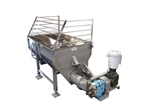
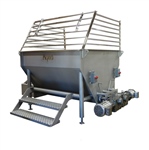
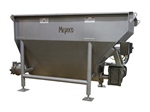
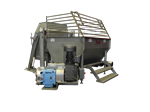
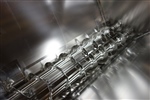


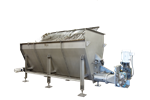
Related Posts
FAQ – INDUSTRIAL PUMP-FEEDER
Mepaco custom designs auger carts from small tabletop solutions to 15,000 pound carts.
ASME thermal jackets are available on pumping systems. In addition, thermal screws are available when the application calls for holding temperature. If your application requires a change in temperature, visit the continuous cooker web page.
Common sizes are 9″ and 12″ diameter, but are available in many sizes depending on the needs of the application. The pitches can be 1 or 2 full pitch, half pitch or variable.
Augers are used effectively to convert a surge on production to a continuous system. Augers used in this manner provide metered flow to convert batch process into a continuous process downstream. They can also be used in automated systems for in-feed applications utilizing controlled metering of ingredients required for the production batch.
Load cells can be used in auger cart systems, if reliable flexibility is designed into the attached pumping and outlet.
Two augers are best used in applications where the flow is very high or the product is very dense and viscous.
Leveling ribbons are used in applications where the product has a tendency to bridge. Their use keep the augers fully primed and fully distributed throughout the hopper.
Cavitation occurs when the pump is not properly primed by the auger(s) that are feeding it. The positive displacement pump is the pacing item for the system; so simply adjust the controls to set the pump for the desired capacity and then dial the augers in to balance the flow.
To evacuate the product out of the line, blow the line with compressed air or use a PIG system.
A pressure transducer is mounted on the transition between the augers and the pump that constantly monitors the pressure. As the pump increases or decreases, the pressure transducers tell the auger(s) to speed up or slow down to maintain the desired NIPR.